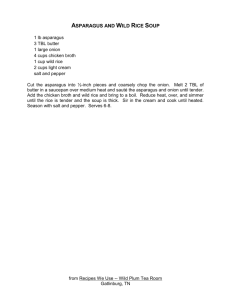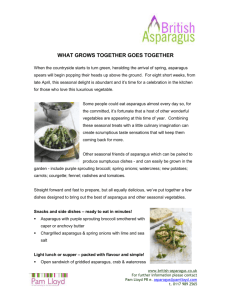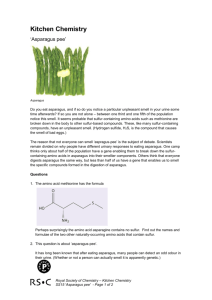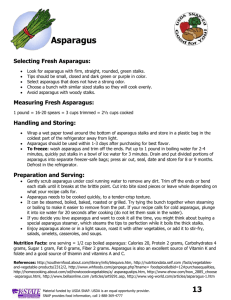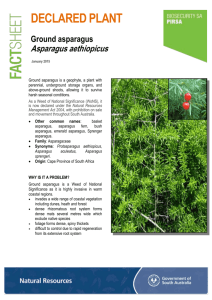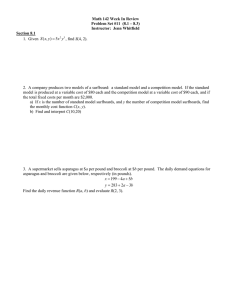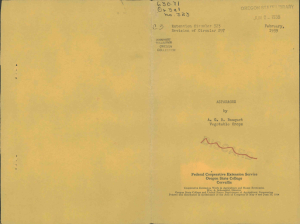O3J (Revision of Ext. Cir. 323) 4G5 Extension Circular
advertisement
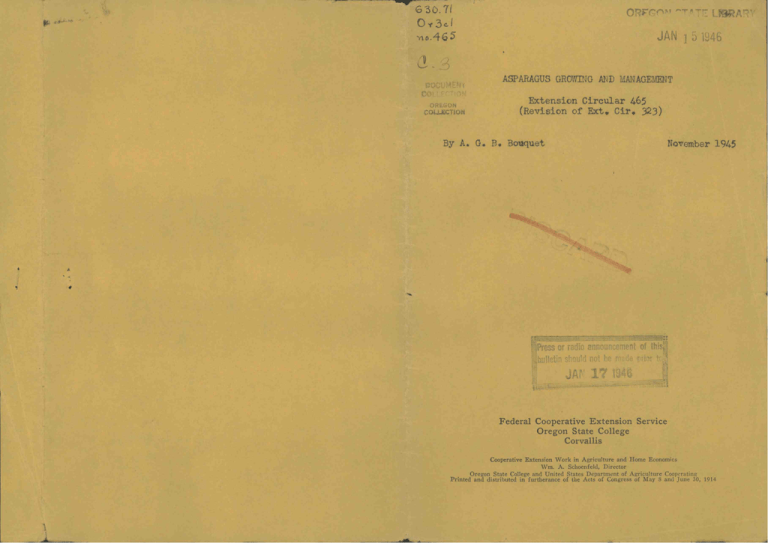
G3oT1 O3J 4G5 5) ASPARAGUS GROVING AND IVIANAGE1NT Extension Circular 465 (Revision of Ext. Cir. 323) By A. 0. B. Bo*quet November 1945 .5 Federal Cooperative Extension Service Oregon State College Corvallis Cooperative Extension Work in Agriculture and Home Economics \Vm. A. Schoenfeld, Director Oregon State College and United States Department of Agriculture Cooperating Printed and distributed in furtherance of the Acts of Congress of May 8 and June 30, 1914 flC*N ,3O.7( Ftension Circular 465 Revision of Circular 323 November 1945 COLCTn ASPARAGUS .O:ING AND M.ANACEMENT by A. G. B. Bouquet Horticulturist (Vegetable Crops) Introduction A complete farm home garden should include a planting of asparagus, which is the most important perennial vegetable. The asparagus plantation should be given a place with the rest of the horticultural crops which are more or less permanent, With rhubarb, also a perennial crop, asparagus should be planted at one side of the garden so that other vegetables that are planted annually will not interfere with it, Asparagus is one of the first vegetables to be harvested in the spring when the garden is almost barren of fresh produce. Once established, the bed will produce annually for several years. When harvested fresh from the garden and cooked shortly thereafter, asparagus stalks have the finest possible quality. The plant is one that adapts itself well to various soil and climatic conditions, and as a consequence, it can be grown in almost any portion of Oregon. Commercially, asparagus is grown in Oregon to the extent of about 800 acres. Small areas of this vegetable for local consumption are to be found in the vicinity of the various cities of the State and larger areas of asparagus for shipment are located along the Columbia River as far as Umatilla county. There is also some acreage planted in the Willasnette Valley for State marketing and for manufacturing. More recently, too, there has been some acreage planted to this crop in eastern Oregon, mostly for processing. From prices of asparagus published by the United States Department of Agriculture, Bureau of Agricultural Economics, the value per crate in 1944 was stated to be $2.35 which was the seasonal market price for open sales and for processing. The number of cases of Oregon asparagus canned in 1944 was 110,815. This pack was all green. In the last few years asparagus has come into greater prominence because of its being processed by quickfreezing, and the number of pounds handled in this way in 1944 for Oregon..Washington was 5,075,343 in eight years from the inception of quick freezing. Production Yrieties. The most widely planted variety at the present time is Mary Washington, which is rust-resistant, a vigorous grower, and which 2 produces stalks which are of good shape and length before feathering, good color and market quality. If setting out a plantation of asparagus from roots, it is especially important to get a good strain of roots of the variety mentioned, or if one is growing one's own roots, the seed should come from selected plants, the pedigree and good characters of which are known, Crowns. Asparagus crowns which are used for starting a planta tion are grown from seed in an outdoor seedbed for one full season before being set out in the permanent bed. Prospective growers of asparagus have the option of buying oneyear.old crowns, or obtaining selected seed and growing their own crowns. There are advantages in either method. If the crop is to be grown on a rather large scale, it may be wiser to buy pedi greed seed and grow the crowns rather than to buy them, but on a small scale, especially for the home garden, it is best to buy the one-year-old crowns ready for planting and thus save a year's time. There are some advantages in growing one T own plants, such as having knowledge of the source and productiveness of the parent plants from which the seed came. There is also greater opportunity of selection of the crowns when digging them and sorting them for putting in the permanent bed. VIhen buying plants, large oneyearold crons are the best for planting. Then buying seed, four to five pounds sown on an acre should produce 30,000 - 40,000 roots, sufficient to set five to seven acres. The asparagus plant produces both male and female plants, of vh ich in the field perhaps 50% are males and 50% females Some experiments seem to indicate that the male plants may produce slightly larger yields of stalks than the female plants, but certain female plants may produce a slightly better grade of asparagus than the male. This question is not one that should In any way concern the grower of 50 to 100 asparagus plants, pro ducing stalks for home consumption. Neither should it be of very great concern to the commercial grower, 'ho provides sufficient fertility for the plantation as a whole. From observations which have been made of the yields of the highest yielding plants as against the average for all plants in the area th pro duction of the ten highest plants was 194% above the average spear produc tion for all plants, while the weight of the stalks from these ten highest plants was 161% above the weight of stalks from all plants. It can readily be appreciated, therefore, that the more uniform the plants are over the field as a whole, the greater will be the yields and the higher the market quality, Some investigators report improved stands obtained from crown selection prior to setting them out. Cull plants should not be used. It is important that the plants be set out in the garden before the crowns have started to make much growth, otherwise the stalks will often tim be broken off, and thus some of the first year's production of stalks and foliage will be lost, It is important, too, that the roots do not suffer drying out before they are planted. Climate. Warm spring and early summer weather induces rapid stalk growth but growth is slow and volume of cuttings is reduced considerably by cool, rainy weather in April and May. 3 Soils. Vthile asparagus is a plant 4lhich adapts itself to a wide variety of soils for home production, from the standpoint of commercial production, a light, friable sandy or silt loam is preferred. Soils that are light in texture arid friable have a tendency to produce earlier and straighter asparagus and can be worked earlier in the spring. In the home garden if the soil is naturally heavy or hard to work, plants can be covered with sandy loam or a lighter type of soil after they are put in the trench, which can be gradually filled in with the lighter soil instead of the natural soil of a more compact type. Asparagus should be planted commercially on well-.drained soils. soil reaction should preferably be slightly acid to neutral. The Fertilizers. It is important to build up the soil to a good level of organic matter and fertility before putting in asparagus plants. Before establishing plantings, applications of rotted manure have been beneficial, Fresh manure may contain weed seeds and cause a grassy growth and the necessity of weed elimination during and after the cutting season. Cover crops of vetch turned under in the early spring have increased yields. Poultry manure has sometimes been found beneficial. Broadcasting of a complete fertilizer of 6-86 has given good increase in yields. Cyanamid at a rate of possibly 500 pounds per acre has been used to advantage in killing some weeds and providing available nitrogen. This material should be applied broadcast several weeks before the cutting season begins. Some growers have profitably added to it an equal amount of superphosphate. Most of the material from which the spears are formed in the spring is stored in the fleshy roots, or the crowns, during the previous summer and fall, It is desirable, therefore, to have as heavy a top growth of foliage as possible after the cutting season is over, The number of commercial fertilizer applications may vary between one and two, depending upon the possibility of irrigation or the amount of rainfall. It would be advantageous to apply some fertilizer after the cutting season, provided there is sufficient moisture available to dissolve the fertilizer. It was formerly considered that salt was necessary in growing asparagus, but it is certain that it is not essential, as very good asparagus is grown without the use of it. It would be better to use commercial fertilizers containing available plant foods which would stimulate growth of the plants and a good production of stalks. Setting the 1toots. The usual distances of setting asparagus plants in the garden are 4-1/2 to 6 feet between the rows and iS to 24 inches between plants in the row. These distances vary considerably as to whether the plantation is commercial or one for home use. The rows can be c].oser together in the home garden or one long row may be sufficient. Commercially, in view of the horizontal and vertical spreading of the roots of the plants, it is advisable to have them no closer than two feet apart in the row, and the rows preferably five to six feet apart. Distances are further apart in the row for blanched or white asparagus, while the asparagus for green cuttings is usually grown at a closer distance between rows. 4 Furrows should be made so that the crowns are set at a depth of approximately eight inches. According to a recent report of the Massachusetts Experiment Station, the results obtained in determining the effect of various depths of planting have shown that deep planting (8 inches) has reduced the stands and thus the yields, while the shallow-planted roots (2 to 4 inches) have apparently not been injured by either cultivation or freezing and thawing. It is, of course, evident that the shallow plantings of two to four inches are virtually impossible and impracticable, but it is important to note, on the contrary, that it is commonly inadvisable to set plants deeper than eight inches. Particularly would this be true where the soil was heavy arid the stalks would have difficulty in penetrating a con siderable amount of solid soil surface in the spring. Most asparagus roots are set out during the spring, and in the fleshy roots are spread out horizontally in the bottom of the and the crowns covered with about a couple of inches of soil when set. Filling in the furrows will take place as the stalks of the grow during the spring and summer. so doing, furrow they are plant Management Maintenance of the Plantation. Sufficient cultivation should be given between the rows and around the plants of asparagus to keep down weeds and to provide a soil mulch. The larger the growth of tops during the summer and fall, the greater will be the cutting the following spring. If water is available for irrigating during the summer, it should by all means be applied as it will cause an increase in the growth of the foliage and the crowns and consequently induce larger future harvestings. Weeds and grassy growth between and in the rows present a most difficult problem, particularly in sonic years when there is a lot of spring rain or a mild winter, It is inadvisable to cut the top growth of the plant until it has been killed by frost or cold weather, Some growers cut these tops with a mowing machine and rake them into a windrow and burn them. In other cases the tops are disked into the soil in the spring when the land is being pre pared for the harvesting season. If the rows of asparagus are 5 - 6 feet apart, it is possible to intercrop with small vegetables between the rows during the first year or so. CarrOts, peas, peppers, cabbage, radishes and lettuce are sometimes used. If there should be any plants missing on the rows the best time to locate these is in the summer of the first year, and then the missing places can be set with crowns during the early spring of the following year. In caring for the plants it is necessary to prevent injury by the common asparagus beetle, which lays black eggs on th stalks and the grubs that later hatch from the eggs eat the fine green fernlike foliage. The recommendations given in Extension Bulletin 551 on "VegetableGarden Insect Pest Control" are as follows, "l(eepthe crop cut clean to market size. Poultry will eat beetles without damaging the crop. A dust containing not less than half of 1 percent rotenone is applied at the rate of 15 pounds per acre whei the beetles first appear in the spring. Applicaticn is repeated. whenever beetles or larvae reappear, £fter the cutting season, foliage is dusted with calcium arsenate or rotenone whenever beetles or larvae appear." Commercial growers of asparagus use small flocks of poultry in various parts of the asparagus area to keep down beetles. Sympjlids have also been known to be very harmful in some aspara gus plantings. There seems to be no established control measure for this pest. Harvesting and preparation for Market There have been some conflicting ideas as to the extent Gutting. to which the asparagus plantation can be cut during the first few years of its existence. Eqeriments which have been conducted at certain experiment stations indicate that heavy cutting of asparagus the first three years in the life of the plantation reduced the yields each year over a period of five years. Tests show that the highest yield has been made by plots which were not cut the first year and only very slightly during the next two years. According to a report of the Illinois Station, in a nineyearold asparagus plantation, the plots that had not been cut until the second year and were cut only lightly the second and third years yielded half again as much later on as asparagus that had been heavily cut from the first year. Heavy cutting the first year after plant setting not only was reflected in a decreased yield but also in a decrease in the average size of spears and in the market quality of the crop. It has been rather substantially sh3wn, therefore, that young asparagus plantings may be per manently injured by the effect of severe cutting in the early years and the These studies were injury is in proportion to the severity of cutting. prompted by the fact that some growers find it difficult to wait until new asparagus plantations are well established before beginning tO cut a crop, Asparagus grows very quickly diring warm weather and therefore must be watched closely in order that it be cut when it Is of the proper length. It is necessary to cut the stalks before they have started to feather, which is the beginning of the opening of the tip and the lateral growth. To have good commercial value, therefore, the stalks should, be straight, tight or free from feathering, and of a desirable diameter and length. Harvesting in Oregon usually begins in midapril and extends for a period of or 10 weeks. depending on weather conditions. Most asparagus stalks are cut level with the ground or just slightly below the soi1 level. Some growers cut the stalks just above th It is inadvisable to cut deeply oi1. into the soil. It is also necessary that care be exercised in cutting those stalks that are large enough to be harvested in such a way as to prevent injury to stalks that are too short to be cut. Experiments have shown that too long a season of cutting the spears is injurious to the general welfare and vigor of the plantation, especially if the season in late spring and early summer is dry. Grading. It is advisable to grade asparagus according to the diaxn-. and length of the stalks. The Oregon standards for asparagus as set forth by the Department of Agriculture, State of Oregon, Division of Plant Industry, are as follows: otor' "Oregon #1 shall consist of clean, well-trimmed, fresh stalks of asparagus fairly uniform in length, which are not wilted or crooked, which do not show broken or spreading tips, and which are free from damage caused by disease, insects or mechanical injury, and shall not show more than 1-1/2 inches of white. In order to allow for variations incident to proper grading and handling, not more than 10% by count of any lot may be below the requirements of this grade. An additional 10% may be allowed for white. "Unclassified shall consist of stalks which do not meet the requirements of the foregoing trade." Size. "In addition to the statement of grade, any lot of asparagus may be classified as small, medium or large, if 80% by count of the stalks in any lot conform to the following requirements for such sizes: sive "Small - 3/8 to 9/16 inches, Medium - 9/16 to 3/4 inches incluLarge - over 3/4 The foregoing table rafers to the maximum diameter of the stalks measured at a point not more than eight inches from the tip. Packing. When bunched in 1-pound or 2-pound bunches, stalks in the bunch shall be fairly uniform in diameter and length. Fairly uniform shall mean that 9-inch asparagus may carry 7-1/2 inches, 8-Inch "grass" may carry 6-.1/2 inches, and 7-inch tgrassfl may carry 5 Inches. Some asparagus is packed un-bunched 'in the crate. The respiration rates of asparagus have been found to be very high and stalks should be kept in a cool place soon after cutting; otherwise there is considerable shrinkage arid undesirable loss of sugar with an increasing amount of fiber, accounting, oftentimes, for the well-known toughness of some spears. The butts of the stalks should stand in a shallow pan of cold water or on ice and set in a cool storage place. The commercial package for marketing asparagus is the pyramid crate, which has a shape conforming to the tapering form of the stalks. This container oftentimes has wet moss on the bottom, and the stalks are frequently wrapped in parchment paper in order to protect them from shrinkage. Local growers in Oregon often use small, narrow paper labels threequarters the length of the bunch, which are inserted in between the rubber bands that hold the stalks together for the purpose of identification of the grower and his brand. Yields. The number and weight of stalks increase after the first few years to reach a high point at possibly the eighth to tenth year after which time there may be neither an increase nor decrease for a few years. The profitable life of a bed may vary considerably according to the natural fertility of the soil and the amount of fertilizer provided for the plants annually, Average yields of established asparagus beds yield from 4000 to 8000 pounds. U.S.D.A. statistics state that the estimated yield of' packed crates per acre is 110,
